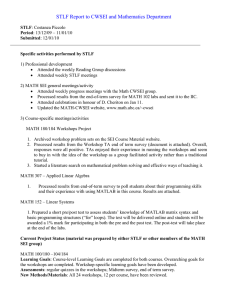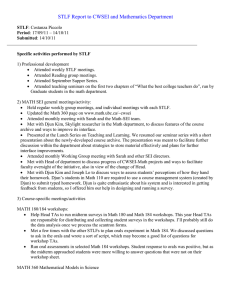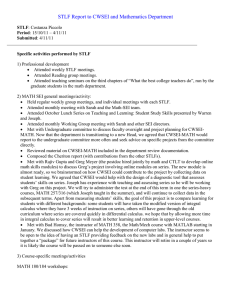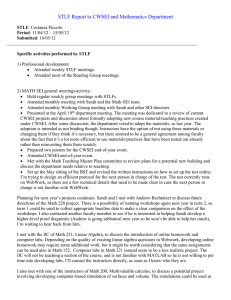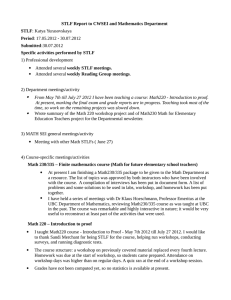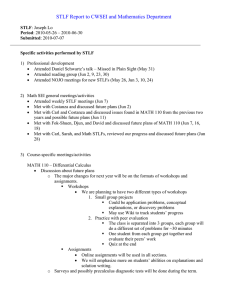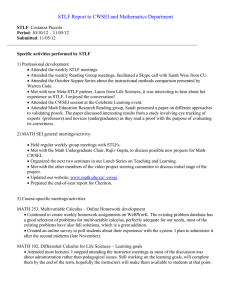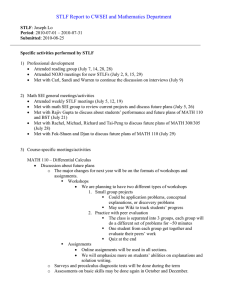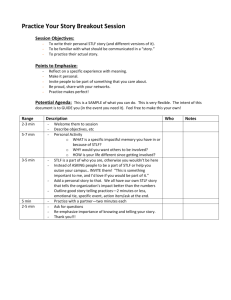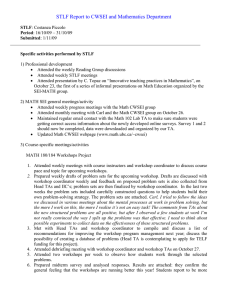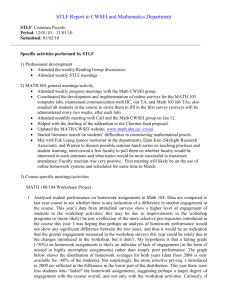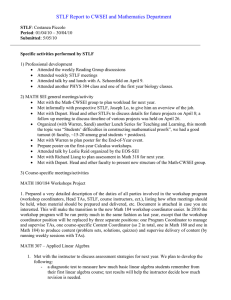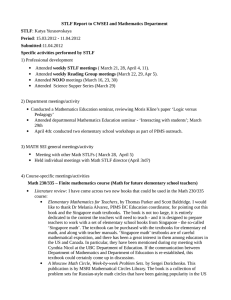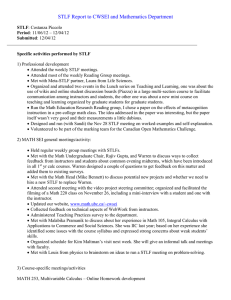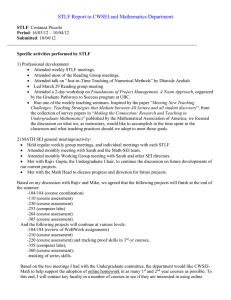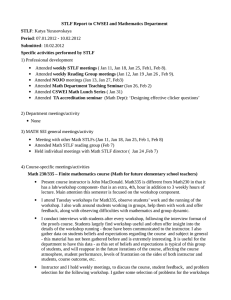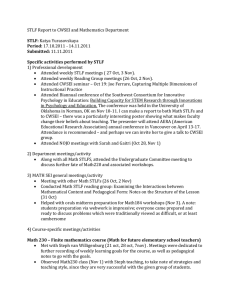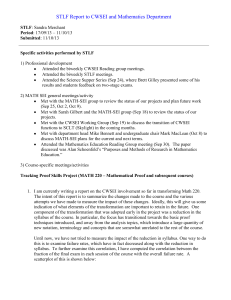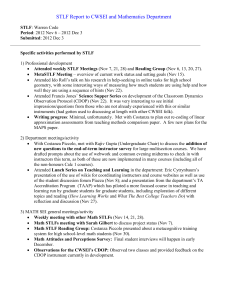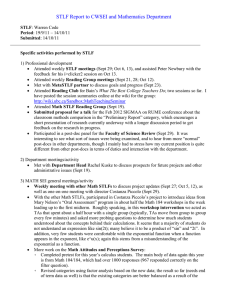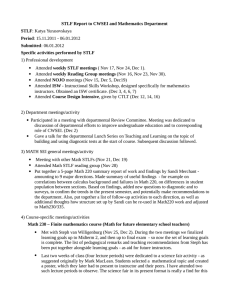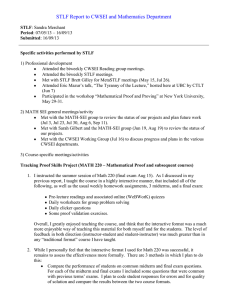STLF Report to CWSEI and Mathematics Department STLF Period Submitted
advertisement
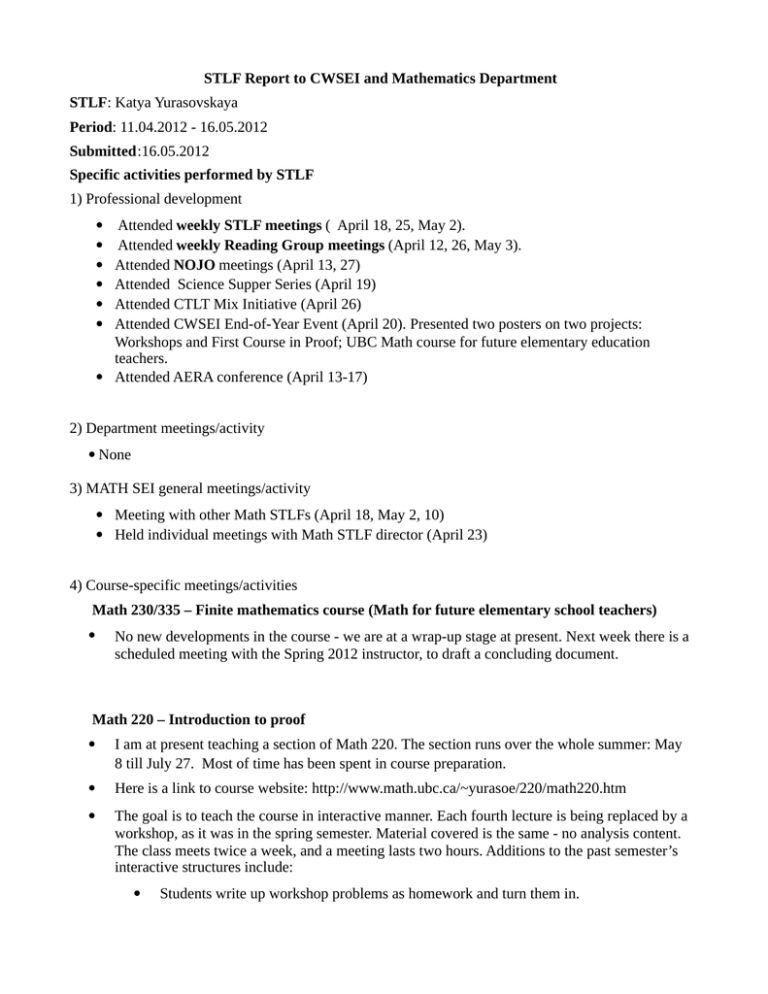
STLF Report to CWSEI and Mathematics Department STLF: Katya Yurasovskaya Period: 11.04.2012 - 16.05.2012 Submitted:16.05.2012 Specific activities performed by STLF 1) Professional development • • • • • • Attended weekly STLF meetings ( April 18, 25, May 2). Attended weekly Reading Group meetings (April 12, 26, May 3). Attended NOJO meetings (April 13, 27) Attended Science Supper Series (April 19) Attended CTLT Mix Initiative (April 26) Attended CWSEI End-of-Year Event (April 20). Presented two posters on two projects: Workshops and First Course in Proof; UBC Math course for future elementary education teachers. • Attended AERA conference (April 13-17) 2) Department meetings/activity • None 3) MATH SEI general meetings/activity • Meeting with other Math STLFs (April 18, May 2, 10) • Held individual meetings with Math STLF director (April 23) 4) Course-specific meetings/activities Math 230/335 – Finite mathematics course (Math for future elementary school teachers) • No new developments in the course - we are at a wrap-up stage at present. Next week there is a scheduled meeting with the Spring 2012 instructor, to draft a concluding document. Math 220 – Introduction to proof • I am at present teaching a section of Math 220. The section runs over the whole summer: May 8 till July 27. Most of time has been spent in course preparation. • Here is a link to course website: http://www.math.ubc.ca/~yurasoe/220/math220.htm • The goal is to teach the course in interactive manner. Each fourth lecture is being replaced by a workshop, as it was in the spring semester. Material covered is the same - no analysis content. The class meets twice a week, and a meeting lasts two hours. Additions to the past semester’s interactive structures include: • Students write up workshop problems as homework and turn them in. • Each workshop includes a group quiz component, in addition to the individual quiz. • Due to longer time period, a review of solved problems during the workshop is possible without time pressure. • 1.5 out of 3 office hours have been turned into a problem-solving session as well. I have booked a large class-room, and students can come and solve problems, work with others, ask me questions, ask for additional questions. • Sandi Merchant is helping run workshop sessions. Thank you, Sandi! • Diagnostic test was given to students at the very beginning of the course. Conclusion for Spring 2012 proofs workshops - comparison of unscaled final exam marks. Comparison of instructor-in-charge sections: 1. Control section: Fall 2010, same instructor, selection of matching material. No workshops. Selection of material in 2010 is easier than that in 2012. Marks adjusted to workshop topics only Conclusion: similar average, which is good: material in 2010 was easier than the one in 2012, since there was more material to cover in 2012. Selection of 2012 problems includes problems that are challenging. Decrease in F’s and increase in A’s is observed. 2. Additional comparison: Fall 2011 – identical course material, homework, textbook. Different instructor. No workshops. Note: we do not use Fall 2011 results as control, so this comparison is rather out of interest. These are raw final exam marks as they are. Conclusion: apparent jump in average, however the numbers even out when one adds sections from the other instructors who taught parallel sections. Again, decrease in F’s and D’s, increase in A’s. Note typo in the graph: ‘2010' was meant to say ‘2011‘. 3. Two Control sections: Fall 2010, data for both instructors combined. Selection of matching material. No workshops. Selection of material in 2010 is easier than that in 2012. Marks adjusted to workshop topics only 2012 Average 68% Median 68% Count 96 SD 15.5% error 1.6% 2010 66% 69% 107 18.9% 1.8% 0.35 Grade Frequencies 0.3 0.25 0.2 2012 2010 0.15 0.1 0.05 0 F A B C D % -% -% -% -% -<50 <80 <68 <55 = 80 & & > & 8% 5% 0% >=6 >=5 >=5 Conclusion: again, similar average, which is good: material in 2010 was easier than the one in 2012, since there was more material to cover in 2012. Selection of 2012 problems includes problems that are challenging. Some decrease in F’s , an apparent increase in A’s. 4.Additional comparison: Fall 2011, data for both instructors. identical course material, homework, textbook. Different instructor. No workshops. These are raw final exam marks. Note: again, Fall 2011 sections are not used as control - rather, as a comparison out of interest. 2012 Average 66% Median 64% Count 96 SD 15.4% error 1.6% 2011 65% 65% 111 17.7% 1.7% 0.35 Grade Frequencies 0.3 0.25 0.2 0.15 0.1 0.05 0 F -- A -- B -- C -- D % -80% 80% 68% 55% <50 < < < = & & > & 8% 5% 0% >=6 >=5 >=5 2012 2011 Conclusion: we can say that there is no increase in average. However, there is still a tendency to a decrease in F’s and a rise in A’s, with an overall upward shift of grade frequencies. Current Project Status (material prepared STLF and/or other members of MATH SEI group) Math 220 – Introduction to proof Learning Goals: no new additions. Assessments: • none New Methods/Materials: • Gather data on students performance when turning in written-up workshop problems Math 230/335 – Finite Mathematics Learning Goals: none. Assessments: • none New Methods/Materials: • none Plan for immediate future work Math 220 – Introduction to Proof 1 Wrap up the spring 2012 proofs project by mid-June. 2 Give thought to a third version of learning goals, as the summer course goes on. Math 230 / Math 335 – Finite Mathematics 1 Wrap up 230/335 project. Compose document with recommendations to department. Make collected materials available to the department for use.
